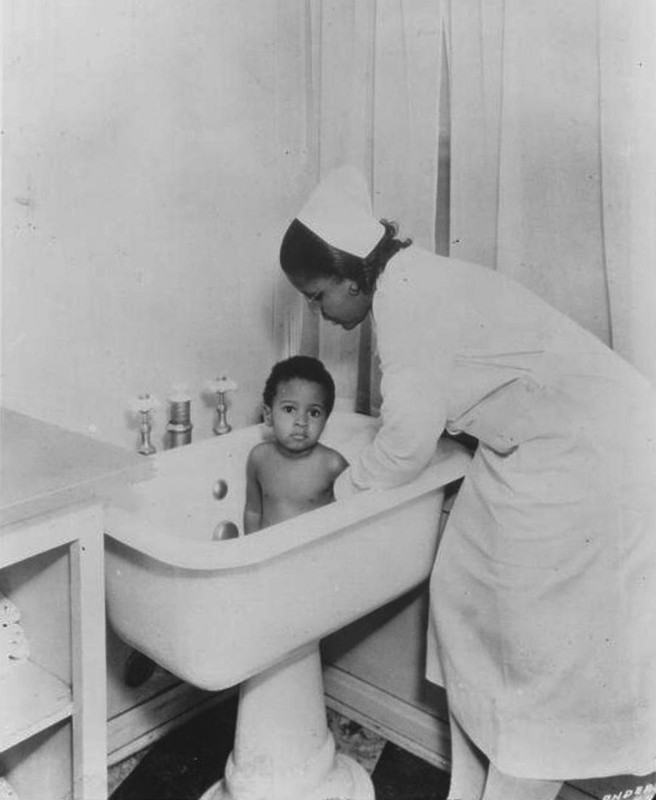Florence Home for Colored Girls (1925-Circa 1970)
Introduction
Text-to-speech Audio
Established in 1925, Florence Home for Colored Girls was an organization dedicated to assisting African American mothers and their children by providing counseling, education, shelter, and medical care in Kansas City. The home was initially located at 2446 Michigan Street and later moved to an expanded facility at 2228 Campbell Avenue. In the 1970s, the Florence Home for Colored Girls became the Florence Home and merged with the previously white-only Florence Crittenton Home.
Images
Florence Crittenton Home, 4th and Main streets, Kansas City, Missouri

Bathing a child at the Florence Home for Colored Girls, ca. 1930

Backstory and Context
Text-to-speech Audio
The Florence Home for Colored Girls was an organization dedicated to assisting African American mothers and their children with obtaining counseling, education, shelter, and medical care in the Kansas City area in the mid-20th century. Initially opened in 1925 at 2446 Michigan Street, the home could only assist approximately seven mothers and their children at once. In the 1930s, the Florence Home for Colored Girls moved to an expanded facility at 2228 Campbell Avenue. The new facility was a four-story colonial-style home that served pregnant women as young as twelve years old and as old as thirty-five years old. The entire project was initially spearheaded by Elizabeth Bruce Crogman, a volunteer with the Urban League and Jackson County's juvenile court, with the help of Kansas City philanthropist William Voelker (Spoerre). Crogman retired from her position as director in 1945.
In 1958, the Florence Home for Colored Girls became simply the Florence Home. In the 1970s, the Florence Home merged with the previously whites-only Florence Crittenton Home. Anna Spoerre wrote for The Kansas City Star in 2021 that "Expectant mothers [played] games in a community meeting room and [ate] meals at a dining hall. The place had a college dormitory feel, in ways. But unlike a college dorm, there was a nurse who checked on the girls and women and accompanied them to the hospital, where, by then, they were taken to give birth. A teacher from the Kansas City school district was also hired to help the girls keep up their education (Spoerre)." The neighborhood of Kansas City where the Florence Home for Colored Girls used to stand on Campbell Avenue is now a parking lot in the Hospital Hill area.
Sources
Bernard, Diane and Bogen-Oskwarek, Maria. The maternity homes where ‘mind control’ was used on teen moms to give up their babies, The Washington Post. November 19th 2018. https://www.washingtonpost.com/history/2018/11/19/maternity-homes-where-mind-control-was-used-teen-moms-give-up-their-babies/.
Johnson, Mary. A Study of the Services Rendered Unmarried Mothers By the Florence Crittenton
Home, Kansas City, Missouri, January–December 1947. Atlanta, Georgia. June 1949.
Spoerre, Anna. 2021. “Unwed Black Mothers in 20th Century Kansas City Found Refuge in Home for Women, Girls.” Kansas City Star, The (KS), May 13, 2021. https://search-ebscohost-com.proxy.library.umkc.edu/login.aspx?direct=true&db=pwh&AN=2W63167678581&site=eds-live&scope=site.
Roe, Jason. “Florence Home for Colored Girls.” The Pendergast Years, December 8, 2017.
https://pendergastkc.org/article/buildings-orgs/florence-home-colored-girls.
Courtesy of the Missouri Valley Special Collections, Kansas City Public Library, Kansas City, Missouri
Courtesy of the Missouri Valley Special Collections, Kansas City Public Library, Kansas City, Missouri
